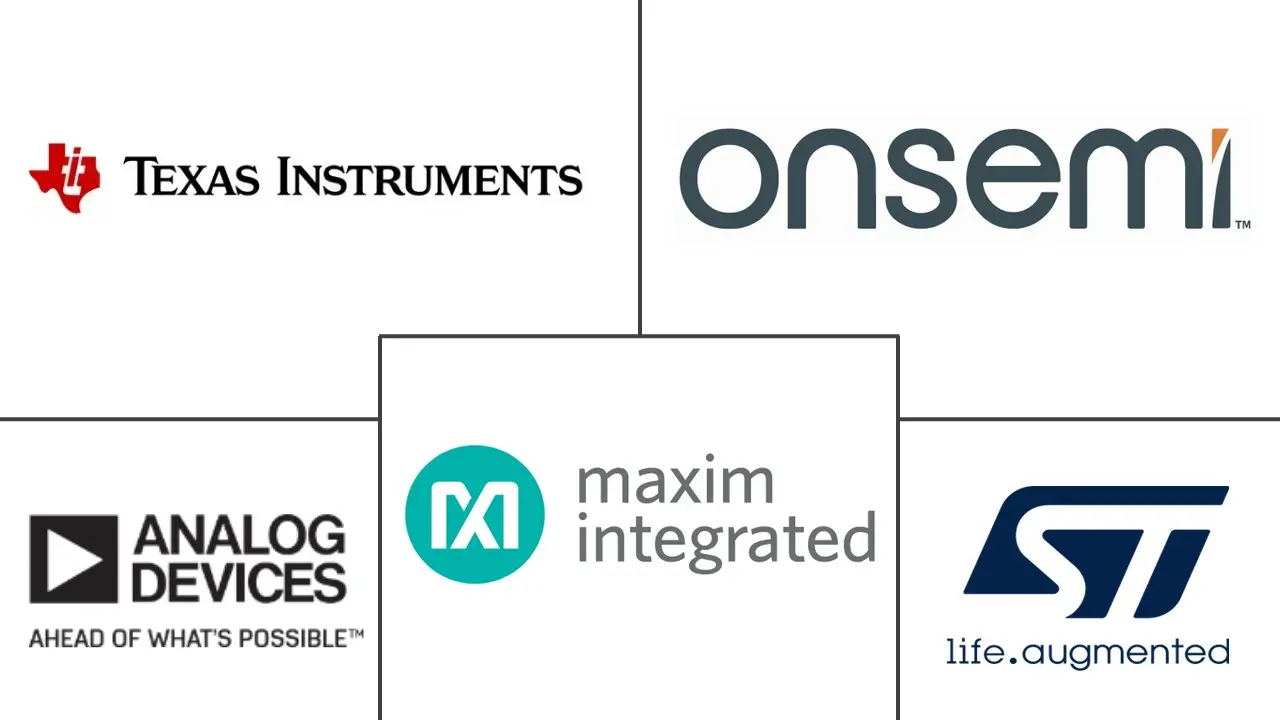Semiconductor In Healthcare Market Size
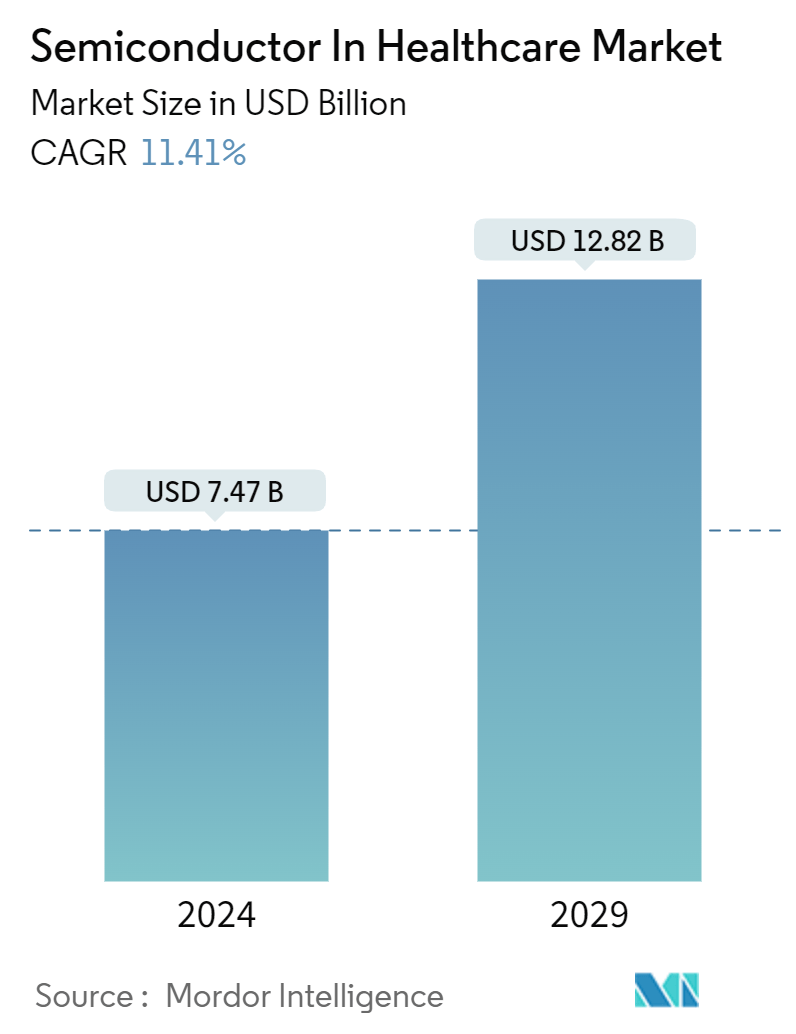
| Study Period | 2019 - 2029 |
| Market Size (2024) | USD 7.47 Billion |
| Market Size (2029) | USD 12.82 Billion |
| CAGR (2024 - 2029) | 11.41 % |
| Fastest Growing Market | Asia Pacific |
| Largest Market | North America |
Major Players*Disclaimer: Major Players sorted in no particular order |
Semiconductor In Healthcare Market Analysis
The Semiconductor In Healthcare Market size is estimated at USD 7.47 billion in 2024, and is expected to reach USD 12.82 billion by 2029, growing at a CAGR of 11.41% during the forecast period (2024-2029).
Many devices used in the healthcare industry rely on semiconductor manufacturing technology. Semiconductor components, such as sensors, integrated circuits (ICs), discrete devices, and memory power management devices, are driving various applications in fields, including medical imaging, clinical diagnostics and therapy, and portable and home healthcare.
- The market is witnessing various developments in medical devices that are expected to increase the need for advanced semiconductors. Portable dialysis machines are gaining market traction, and vendors like Baxter have received FDA clearance post-pandemic that is designed to directly connect electronic medical records for patients' prescriptions and treatment data. Such developments are driving the need for advanced semiconductors.
- Factors like increasing use of remote patient monitoring devices, development in diagnostic and treatment modalities, and high incidence of non-communicable diseases are also expected to drive the growth of the semiconductor in the healthcare market. For instance, the American Cancer Society predicts that there will be 234,580 new cases of lung and bronchus cancer diagnosed in the United States overall in 2024. The state of Florida is reported to have the most significant number of these instances. Even though there are multiple treatment options, modern cryosurgery technology gives a complete cure.
- Furthermore, according to the IARC's World Cancer Report, despite constant progress in cancer prevention and treatment, the global cancer burden is still growing as the number of new cases is anticipated to increase by 50% between 2018 and 2040. IARC detected 10.1 million new cancer cases in 2000 and 18.1 million in 2018, and the number is projected to increase to 27 million new cancer cases per year by 2040.
- A significant number of healthcare professionals and hospitals still use various legacy hardware that need to be in line with current technological standards and are incapable of upgrading to new tech. In addition to this, there is a huge market for pre-owned medical technology worldwide, owing to the need for more availability and funding for such devices, which is hampering the growth and adoption of new technology.
- The Russia-Ukraine War is impacting the supply chain of semiconductors. Being a significant supplier of raw materials for producing semiconductors and electronic components, including various equipment. The dispute has disrupted the supply chain, causing shortages and price increases for these materials, impacting manufacturers and potentially leading to higher costs for end users.
- Further, according to UkraineInvest, copper prices escalated to USD 10,845/mt in early March 2022; however, it eased somewhat in 2023. The war between Russia and Ukraine, high energy costs, and stricter emissions standards in Europe have been noted as the primary reasons for the continued shortage of copper.
Semiconductor In Healthcare Market Trends
Medical Imaging to be the Fastest-growing Application
- The medical imaging segment consists of computed tomography, magnetic resonance imaging, X-ray, and positron emission tomography that find applications in diagnosing various diseases, such as cancer and chronic diseases, via medical imaging.
- With the advancements in technology and the increasing adoption of technology in the healthcare sector, many advances were seen in medical radiation regarding equipment and techniques.
- Over the past few years, one of the significant advancements in interventional X-ray has been an increased focus on core and supporting technologies to provide high-quality, high-resolution images without a corresponding increase in radiation dose. This has been a critical driver behind technological advancements, such as Siemens' Artis Q, Philips' ClarityIQ and Q.zen technology, GE Healthcare's image-guided systems (IGS), and Toshiba's Infinix Elite product line. These have been driving the demand for advanced semiconductors.
- Owing to the increasing focus on radiological diagnostic tests and the rising burden of chronic diseases, the medical devices industry is witnessing growth in yearly imaging and diagnostic tests performed.
- According to the United Nations World Population Prospects, the number of people aged 65 years and over is steadily increasing. The number of older people (60 years and older) around the world is estimated to increase to 2 billion by 2050, of which 80% will live in low-income and middle-income countries. Therefore, the growing elderly population and increasing number of orthopedic and cardiovascular procedures are likely to further promote the adoption of medical imaging in healthcare applications.
- In the medical sector, dental applications require smaller and shorter scans. According to the Listerine Professional, oral conditions are the most faced health issues affecting 3.9 billion people globally. Therefore, in the dental sector, the primary demand for X-ray imaging is expected to increase and drive the demand for various semiconductors in the market studied.
- Furthermore, several companies are launching products associated with X-ray image analysis software to positively impact the segment's growth. For example, in January 2024, Carestream Health launched the DXR-Excel Plus, which is a two-in-one system for both fluoroscopy and general radiology that facilitates real-time images for a wide range of exams while providing features that help create an enhanced experience for users, patients, and administrators.
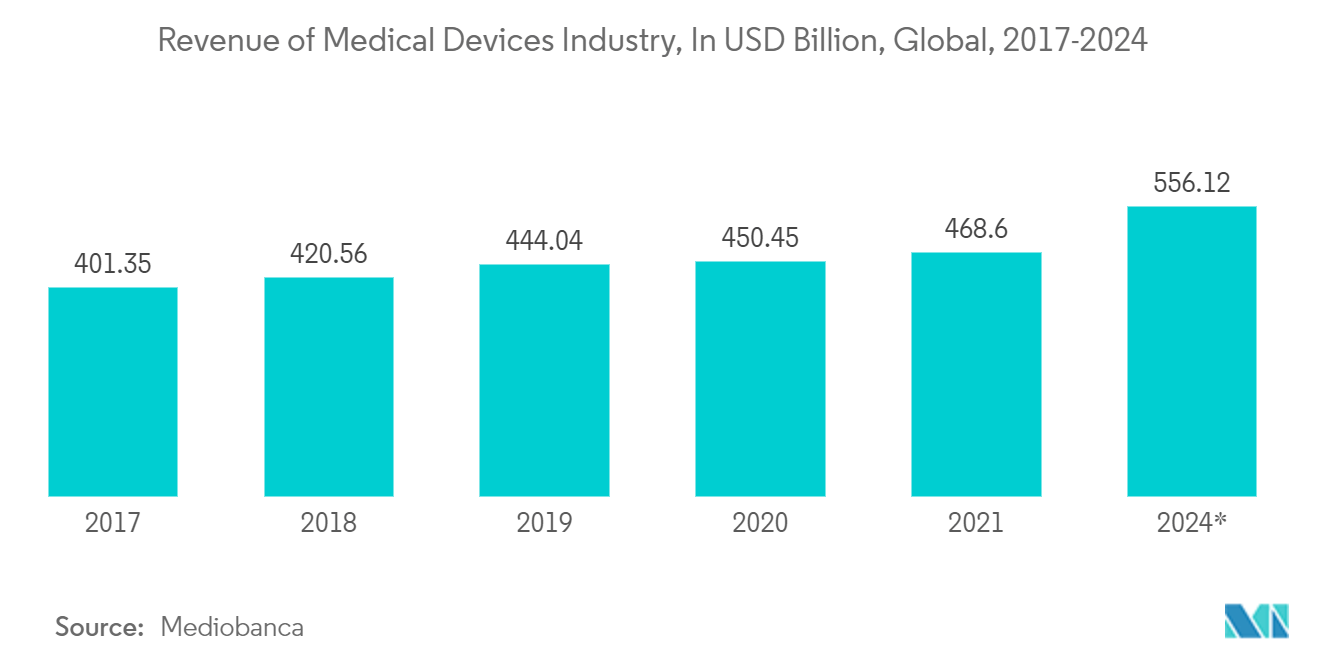
Asia-Pacific is Expected to be the Fastest-growing Market
- Asia-Pacific is expected to expand healthy during the forecast period. Key growth factors include increased investment in research and innovation centers, government programs, and policies to promote the IT and healthcare equipment and devices market. Additionally, the region is also the world's largest semiconductor market. This is due to countries like China, Japan, India, Taiwan, South Korea, and Singapore. These countries contribute to the growth of the healthcare segment.
- In Japan, companies invest in healthcare to build advanced businesses and achieve sustainable growth. For instance, FUJIFILM Holdings Corporation launched a new medium-term management plan, VISION2023, covering three years from the fiscal year ending March 2022 (FY2021) to FY2023. Over three years, VISION2023 foresees investments totaling USD 8.491 trillion to accelerate business growth, focusing on healthcare and highly functional materials businesses. The healthcare business will be expanded to the most considerable revenue and operating income segment to build a robust business foundation that enables sustainable growth.
- Moreover, China's State Council's 2014 National Integrated Circuit Industry Development Guidelines set the goal of becoming a world leader in all areas of the semiconductor industry by 2030. Furthermore, the Made in China 2025 initiative emphasizes semiconductor manufacturing as crucial to China's future economy and society. In addition, the country spent USD 574 billion on the healthcare sector.
- Additionally, South Korea is one of the major consumers, investors, and innovators in the market studied. South Korea's strong presence in the semiconductor industry and medical device manufacturing is helping the country strengthen its presence in the global semiconductor healthcare market. The government also plays a significant role in developing the domestic market, mainly to drive its economy.
- Moreover, the country utilizes AI in its pharmaceutical industry, further expanding the market. According to the government, South Korea's AI-driven drug development market is expected to grow by 40% annually and reach USD 3.9 billion in 2024.
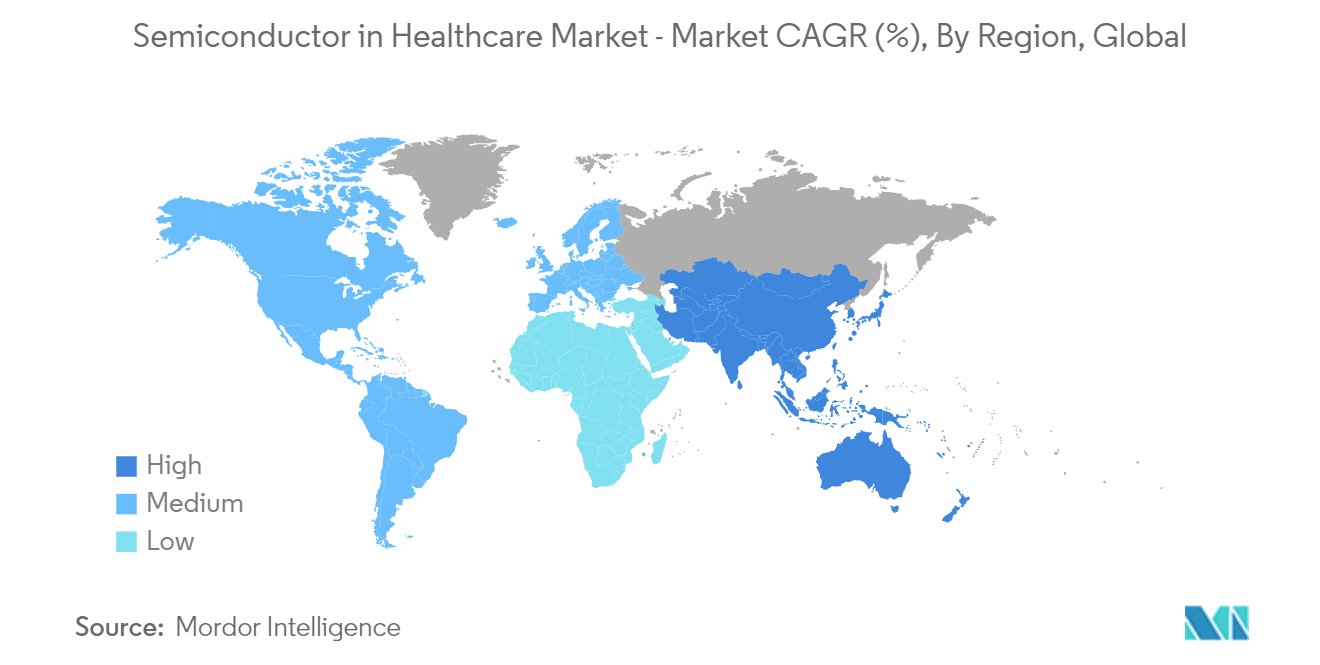
Semiconductor In Healthcare Industry Overview
The semiconductor in the healthcare market is expected to grow moderately during the forecast period. The major players in the market, like Texas Instruments Incorporated, On Semiconductor Corporation, Analog Devices Inc., Maxim Integrated Products Inc., and STMicroelectronics, are adopting strategies such as partnerships and acquisitions to enhance their product offerings and gain sustainable competitive advantage.
- November 2023: Miller announced its strategic plan to acquire Sentron, which is a fully integrated pressure and pH sensor manufacturing company for advancing medical understanding and enabling scientific discoveries through pressure sensor technology.
- November 2023: DuPont Liveo Healthcare announced its collaboration with STMicroelectronics to develop a new smart wearable device concept for remote biosignal monitoring, which employs multifunctional microsensors and control electronics from ST embedded in a flexible patch design from DuPont.
Semiconductor In Healthcare Market Leaders
-
Texas Instruments Incorporated
-
ON Semiconductor
-
Analog Devices Inc.
-
Maxim Integrated Products Inc.
-
STMicroelectronics
*Disclaimer: Major Players sorted in no particular order
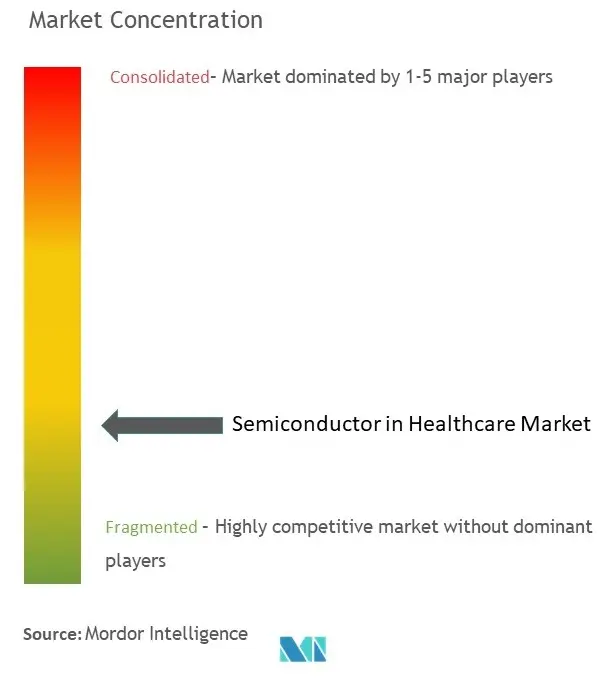
Semiconductor In Healthcare Market News
- November 2023: As per a study from the journal Nature Medicine, researchers came up with a wireless broadband acoustic-mechanical sensing (BAMS) system for continuous physiological monitoring. Among children suffering from cardiovascular and gastrointestinal problems, continuous monitoring systems help guide clinical decisions.
- October 2023: Maxic announced the launch of MT3102, which is a miniature, ultra-low power digital optical proximity sensor integrating 940 nm VCSEL and found its main application in wireless Bluetooth earphones such as TWS/OWS, portable hardware products, smartwatches, and smartphones.
Semiconductor In Healthcare Market Report - Table of Contents
1. INTRODUCTION
- 1.1 Study Assumption and Market Definition
- 1.2 Scope of the Study
2. RESEARCH METHODOLOGY
3. EXECUTIVE SUMMARY
4. MARKET INSIGHTS
- 4.1 Market Overview
-
4.2 Industry Attractiveness - Porter's Five Forces Analysis
- 4.2.1 Bargaining Power of Suppliers
- 4.2.2 Bargaining Power of Buyers
- 4.2.3 Threat of New Entrants
- 4.2.4 Threat of Substitutes
- 4.2.5 Intensity of Competitive Rivalry
- 4.3 Industry Value Chain Analysis
- 4.4 Assessment of the Impact of Key Macro Trends on the Market
5. MARKET DYNAMICS
-
5.1 Market Drivers
- 5.1.1 Growth of Connected Devices in Medicines
- 5.1.2 Need for Advanced Semiconductor Technology for Better Medical Care
-
5.2 Market Restraints
- 5.2.1 Revamp of the Existing Hardware and High Equipment Cost of the End-use Product
6. MARKET SEGMENTATION
-
6.1 By Application
- 6.1.1 Medical Imaging
- 6.1.2 Consumer Medical Electronics
- 6.1.3 Diagnostic Patient Monitoring and Therapy
- 6.1.4 Medical Instruments
-
6.2 By Component
- 6.2.1 Integrated Circuits
- 6.2.1.1 Analog
- 6.2.1.2 Logic
- 6.2.1.3 Memory
- 6.2.1.4 Micro Components
- 6.2.2 Optoelectronics
- 6.2.3 Sensors
- 6.2.4 Discrete Components
-
6.3 By Geography***
- 6.3.1 North America
- 6.3.2 Europe
- 6.3.3 Asia
- 6.3.4 Australia and New Zealand
- 6.3.5 Latin America
- 6.3.6 Middle East and Africa
7. COMPETITIVE LANDSCAPE
-
7.1 Company Profiles*
- 7.1.1 Texas Instruments Incorporated
- 7.1.2 ON Semiconductor Corporation
- 7.1.3 Analog Devices Inc.
- 7.1.4 Maxim Integrated Products Inc.
- 7.1.5 STMicroelectronics
- 7.1.6 NXP Semiconductors NV
- 7.1.7 Broadcom Inc.
- 7.1.8 ams Osram
- 7.1.9 Vishay Intertechnology Inc.
- 7.1.10 Renesas Electronics Corporation
8. INVESTMENT ANALYSIS
9. FUTURE OF THE MARKET
** Subject To AvailablitySemiconductor In Healthcare Industry Segmentation
Semiconductors are essential technology enablers that power many cutting-edge digital devices. A significant number of devices utilized in healthcare is dependent on semiconductor manufacturing technology, which incorporates sensors and motion micro-electromechanical systems (MEMS), microcontrollers, communication integrated circuits (ICs), discrete devices, memory power management devices, and analog, digital, and mixed-signal ICs. These devices are driving a large number of applications in fields such as clinical diagnostics and therapy, medical imaging, and portable and home healthcare.
The semiconductor in healthcare market is segmented by application (medical imaging, consumer medical electronics, diagnostic patient monitoring and therapy, and medical instruments), component (integrated circuits [analog, logic, memory, and micro components], optoelectronics, sensors, and discrete components), and geography (North America, Europe, Asia-Pacific, Latin America, and Middle East and Africa). The market sizes and forecasts are provided in terms of value (USD) for all the above segments.
| By Application | Medical Imaging | |
| Consumer Medical Electronics | ||
| Diagnostic Patient Monitoring and Therapy | ||
| Medical Instruments | ||
| By Component | Integrated Circuits | Analog |
| Logic | ||
| Memory | ||
| Micro Components | ||
| By Component | Optoelectronics | |
| Sensors | ||
| Discrete Components | ||
| By Geography*** | North America | |
| Europe | ||
| Asia | ||
| Australia and New Zealand | ||
| Latin America | ||
| Middle East and Africa |
Semiconductor In Healthcare Market Research FAQs
How big is the Semiconductor In Healthcare Market?
The Semiconductor In Healthcare Market size is expected to reach USD 7.47 billion in 2024 and grow at a CAGR of 11.41% to reach USD 12.82 billion by 2029.
What is the current Semiconductor In Healthcare Market size?
In 2024, the Semiconductor In Healthcare Market size is expected to reach USD 7.47 billion.
Who are the key players in Semiconductor In Healthcare Market?
Texas Instruments Incorporated, ON Semiconductor, Analog Devices Inc., Maxim Integrated Products Inc. and STMicroelectronics are the major companies operating in the Semiconductor In Healthcare Market.
Which is the fastest growing region in Semiconductor In Healthcare Market?
Asia Pacific is estimated to grow at the highest CAGR over the forecast period (2024-2029).
Which region has the biggest share in Semiconductor In Healthcare Market?
In 2024, the North America accounts for the largest market share in Semiconductor In Healthcare Market.
What years does this Semiconductor In Healthcare Market cover, and what was the market size in 2023?
In 2023, the Semiconductor In Healthcare Market size was estimated at USD 6.62 billion. The report covers the Semiconductor In Healthcare Market historical market size for years: 2019, 2020, 2021, 2022 and 2023. The report also forecasts the Semiconductor In Healthcare Market size for years: 2024, 2025, 2026, 2027, 2028 and 2029.
Semiconductor In Healthcare Industry Report
Statistics for the 2024 Semiconductor In Healthcare market share, size and revenue growth rate, created by Mordor Intelligence™ Industry Reports. Semiconductor In Healthcare analysis includes a market forecast outlook to for 2024 to 2029 and historical overview. Get a sample of this industry analysis as a free report PDF download.

